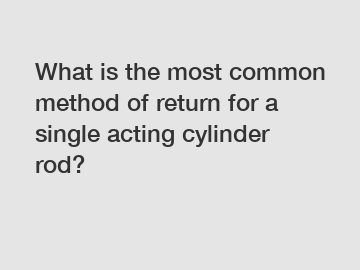What is the most common method of return for a single acting cylinder rod?
What is the most common method of return for a single acting cylinder rod?
A single acting cylinder is a type of hydraulic or pneumatic cylinder that operates in only one direction. It usually consists of a cylindrical tube, a piston, and a rod attached to the piston. When pressure is applied to one side of the piston, it pushes the rod outwards, performing work. However, when the pressure is removed, the piston does not return on its own. Hence, a return mechanism is required to bring the rod back to its original position. There are several methods of return used for single acting cylinder rods, but the most common one is the spring return method.
Spring Return Method: The Basics.

The spring return method is widely used because it is simple, cost-effective, and reliable. In this method, a mechanical spring is placed inside the cylinder tube to provide the required force for returning the rod. When pressure is applied to extend the rod, the spring is compressed, storing potential energy. When the pressure is released or reversed, the stored energy in the spring pushes the rod back to its initial position, completing the return stroke.
Advantages of the Spring Return Method.
There are several advantages to using the spring return method for single acting cylinder rods:
1. Cost-effectiveness: Compared to other return methods, the spring return method is relatively inexpensive. The components required, namely the spring and the necessary supports, are readily available and affordable.
2. Simplicity: The design and implementation of the spring return method are simple, making it easier to understand and maintain. There are no complex mechanisms or additional components required, reducing the chances of failure or breakdown.
3. Reliability: The spring return method has proven to be highly reliable over time. The springs have a longer lifespan, and their ability to store and release energy remains consistent even after numerous stroke cycles.
4. Energy efficiency: With the spring return method, the energy used to extend the rod is stored in the spring during the extension stroke. This stored energy is then used to return the rod during the compression stroke, making the system more energy efficient.
Considerations and Potential Issues.
While the spring return method is widely used and offers several advantages, there are a few considerations and potential issues to keep in mind:
1. Spring selection: The correct selection of the spring is crucial for achieving optimal performance. The spring must have the appropriate stiffness and strength for the desired stroke length and force. Consultation with an experienced engineer or spring manufacturer is advisable to ensure the correct spring is chosen for the application.
2. Space limitations: The inclusion of a spring inside the cylinder tube may require additional space, which might be a concern in applications with limited space availability. Careful consideration of the cylinder design and dimensions is necessary to accommodate the spring effectively.
3. Maintenance: While the spring return method is generally low maintenance, periodic inspection and cleaning of the spring are recommended to ensure its functionality and longevity. Regular checks for any signs of wear or deformation can prevent potential issues and ensure reliable operation.
Closing paragraph:
In conclusion, the most common method of return for a single-acting cylinder rod is the spring return method. Its simplicity, reliability, and cost-effectiveness make it a popular choice across various industries. When selecting the spring and designing the cylinder, it is crucial to consider the specific requirements of the application and consult with experts if needed. If you have any further questions or need assistance with single-acting cylinder rods, please feel free to contact us.
Want more information on customized stainless steel hydraulic cylinder manufacturer, customized multi stage hydraulic ram, disadvantages of single acting cylinder? Feel free to contact us.
220
0
0

Comments
All Comments (0)